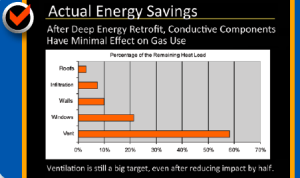Editor’s Note: To read details about Castle Square Apartments’ deep-energy retrofit, see “Boston’s Big DER”, page 38, November-December 2012 issue, or view the story online.
The renovation of Castle Square Apartments, a 1960s, 7-story apartment building, is likely the largest example of a deep-energy retrofit (DER) in the U.S. A DER is defined as a renovation with 50 percent or higher energy savings. The affordable housing property’s residents and design/development team had the ambitious goal of achieving deep-energy savings without a gut rehab and without relocating residents. Measures included a new super-insulated exterior shell, extensive air sealing, high-efficiency heating/cooling equipment, solar thermal, green materials, water-efficient fixtures, improved ventilation, construction material recycling and ecologically sensitive landscaping.
With construction completed in April 2012, Castle Square was certified LEED for Homes Midrise Platinum by the U.S. Green Building Council, Washington, D.C. Post-renovation energy data at Castle Square prove DER goals are achievable on buildings of this scale, and practitioners should strive to reach beyond the typical 30 percent energy-savings ceiling that exists in most renovations.
Electric Savings
Castle Square has minimal common-area electric bills. Residents pay for their own apartment lighting, air conditioning, refrigerators and plug loads. Because residents pay for apartment electricity, they are expected to see the savings firsthand in reduced bills. Meter readings prior to the renovation, from 2008-10, demonstrated total electric consumption (common areas and apartments) was 697,800 kilowatt hour, or $98,500 per year.
As of this publication, electric data are still being analyzed. It’s a slow process because of the challenges of gaining access to and reviewing 192 individual apartment bills and making sure the residents who live in a given apartment today also lived there before the renovation. Without consistent data from the same apartment, it is extremely difficult to determine post-improvement electric savings in individual apartments.
Gas Savings
Post-construction gas consumption was normalized for weather to compare it to annual preconstruction gas consumption from 2008-10. From August 2012 through July 2013, the renovated building achieved 52 percent overall savings compared to preconstruction gas consumption. To break this down further, by the summer of 2013, Castle Square was using 45 percent less gas for hot water and 58 percent less gas for heat compared to pre-renovation conditions.
Actual annual bills for natural gas at Castle Square have dropped from $237,000 (139,500 therms) to $114,000 (67,300 therms), a savings of 52 percent. Gas calculations assume a cost of $1.70 therm.


